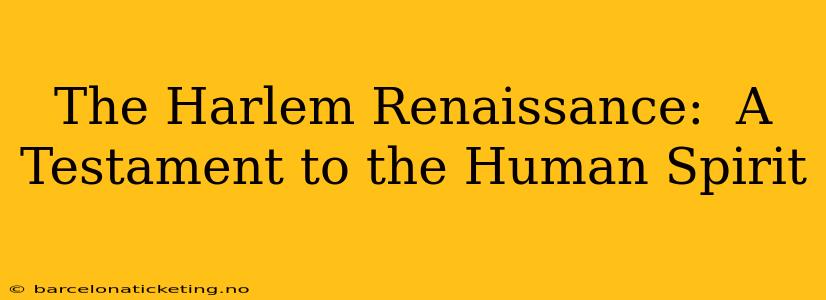The Harlem Renaissance, a period of unprecedented artistic and intellectual flourishing in the 1920s and 30s, stands as a powerful testament to the resilience and creativity of the African American community. More than just a cultural movement, it was a social and political awakening, a vibrant explosion of literature, music, art, and dance that challenged racial stereotypes and redefined the American identity. This era, centered in Harlem, New York City, left an indelible mark on American culture and continues to inspire and resonate today.
What sparked the Harlem Renaissance?
Several factors converged to create the fertile ground for the Harlem Renaissance. The Great Migration, the mass movement of African Americans from the rural South to the urban North, brought a large influx of talented individuals to Harlem. This concentration of artists, writers, and thinkers fostered a dynamic intellectual environment, fueled by a shared experience and a collective desire for self-expression and empowerment. Furthermore, the burgeoning Black middle class provided the economic support needed to sustain the burgeoning cultural scene. Finally, a growing sense of racial pride and a determination to challenge racist narratives provided the powerful impetus for artistic and intellectual innovation.
What were the key characteristics of the Harlem Renaissance?
The Harlem Renaissance was characterized by a unique blend of artistic styles and themes. A spirit of experimentation and innovation permeated the movement, resulting in a distinctive aesthetic that reflected both African American heritage and modern sensibilities. Key characteristics include:
- Literary achievements: This era witnessed the rise of literary giants such as Langston Hughes, Claude McKay, and Zora Neale Hurston. Their works explored themes of racial identity, social injustice, and the complexities of the Black experience in America with a powerful blend of realism and lyricism.
- Musical innovations: Jazz music, with its improvisational spirit and rhythmic energy, became a central element of the Harlem Renaissance. Musicians like Duke Ellington and Louis Armstrong pushed the boundaries of musical expression, creating a uniquely American art form. The blues, with its deeply emotional resonance, also played a significant role.
- Visual arts: Painters like Aaron Douglas created bold, stylized works that reflected the cultural dynamism of Harlem. Their art often incorporated African motifs and patterns, celebrating the beauty and richness of Black heritage.
What were the major themes explored during the Harlem Renaissance?
The Harlem Renaissance wasn't simply about aesthetics; it was a powerful response to social and political realities. Central themes explored by artists and writers included:
- Black identity and pride: The movement celebrated Black culture and heritage, challenging the negative stereotypes prevalent in mainstream society. Works of the period emphasized the richness and complexity of the African American experience.
- Racial injustice and inequality: Despite the celebration of Black culture, the pervasive reality of racial discrimination and inequality was a constant theme. Many works directly addressed issues of segregation, violence, and limited opportunities.
- The search for self-discovery and empowerment: The Harlem Renaissance was a journey of self-discovery for many Black artists and writers. They sought to define their own identities and forge their own paths, rejecting the limitations imposed upon them by a racist society.
How did the Harlem Renaissance influence later movements?
The impact of the Harlem Renaissance extends far beyond its immediate context. Its legacy can be seen in numerous subsequent artistic and social movements, including the Civil Rights Movement. The artistic innovations, the spirit of resistance, and the celebration of Black culture laid a crucial foundation for future generations of African American artists and activists. The movement’s emphasis on self-expression and the power of art to effect social change continue to inspire individuals and groups striving for social justice and equality.
How long did the Harlem Renaissance last?
While often associated with the 1920s, the Harlem Renaissance extended into the 1930s and beyond. While the intense creative energy of the mid-to-late 1920s is often considered its peak, the movement's influence continued to shape artistic expression and social thought for years to come. The Great Depression significantly impacted the financial support for artistic endeavors, marking a shift in the movement's intensity, but its legacy remained potent.
What is the significance of the Harlem Renaissance today?
The Harlem Renaissance remains incredibly significant today. It serves as a powerful reminder of the enduring human spirit and the transformative power of art and culture. The works produced during this period continue to be studied and celebrated for their artistic merit and their profound social commentary. Moreover, the movement's emphasis on cultural pride and empowerment continues to resonate with communities around the world striving for social justice and equality. The Harlem Renaissance stands as a testament to the resilience of the human spirit in the face of adversity and a powerful reminder of the transformative potential of art and culture.

